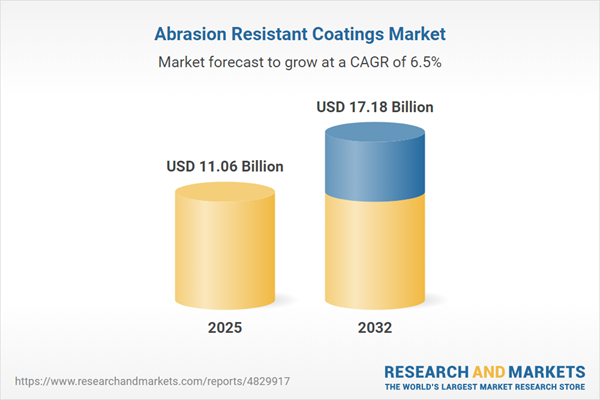Speak directly to the analyst to clarify any post sales queries you may have.
The abrasion resistant coatings market equips senior decision-makers with solutions that protect vital assets and foster operational reliability. These coatings are engineered to extend service intervals, streamline maintenance demands, and reinforce asset value in rigorous industrial settings.
Abrasion Resistant Coatings Market Snapshot
In 2024, the abrasion resistant coatings market reached USD 10.37 billion, with consistent growth projected as it moves toward USD 11.06 billion in 2025 and USD 17.18 billion by 2032. A compound annual growth rate of 6.51% marks the sector’s expansion, underpinned by demand from key industries including aerospace, automotive, manufacturing, oil and gas, and power generation. Senior leaders across these segments leverage advanced coatings to enhance the durability of operational equipment, reduce unscheduled repairs, and respond to evolving regulatory expectations focused on compliance and efficiency. The sector’s evolution is shaped by efforts to optimize asset performance, comply with industry-specific mandates, and ensure continuous output.
Abrasion Resistant Coatings Market: Scope & Segmentation
This section presents a targeted view of where strategic investments and innovation drive value for procurement and operational leaders:
- Coating Technologies: Chemical vapor deposition, physical vapor deposition, electroplating, plasma electrolytic oxidation, and thermal spray methods are prioritized by executives for their impact on hardness and chemical resistance.
- End Use Industries: Aerospace, automotive, construction, manufacturing, marine, oil and gas, and power generation sectors depend on abrasion resistant coatings to reduce part replacement frequency, support extended maintenance cycles, and improve the reliability of critical equipment.
- Coating Materials: Ceramic, composite, metallic, and polymer coatings appeal to leaders aiming for efficiency gains and waste minimization while advancing environmental and sustainability objectives.
- Application Methods: Electrochemical deposition, physical vapor methods, and various spraying technologies meet the needs of automated production and proactive maintenance planning.
- Geographic Regions: The Americas, Europe, Middle East and Africa, and Asia-Pacific each contribute distinct regulatory requirements, supply chain dynamics, and patterns of technology adoption that influence risk assessments and investment strategies.
- Leading Companies: Industry participants such as PPG Industries, Akzo Nobel N.V., The Sherwin-Williams Company, RPM International, BASF SE, Hempel A/S, Jotun A/S, Nippon Paint Holdings, Axalta Coating Systems, and Kansai Paint Co., Ltd. supply innovations and strategic partnerships in the abrasion resistant coatings sector.
Abrasion Resistant Coatings Market: Key Takeaways for Senior Decision-Makers
- Abrasion resistant coatings support increased asset utilization and production consistency, essential in industries exposed to aggressive environments.
- Sustainable coating solutions are integral for aligning operations with environmental, social, and governance (ESG) expectations and industry regulations.
- Utilizing predictive maintenance practices, enabled by advanced coatings, fosters proactive asset management and strengthens compliance outcomes.
- Robust supplier relationships ensure business continuity and mitigate procurement challenges during supply chain fluctuations.
- Investment in digital platforms for real-time surface monitoring accelerates maintenance response, reducing the risk of critical disruptions.
- Collaboration with regulatory bodies and solution providers shortens the timeline for obtaining approvals and integrating compliant coatings into existing processes.
Tariff Impact: Navigating Trade Policy Disruptions
Forthcoming U.S. tariff adjustments for 2025 are expected to affect the accessibility and pricing of essential inputs such as powders, ceramics, and specialty chemicals pivotal to abrasion resistant coatings. Senior executives can address these challenges by diversifying supplier networks, establishing flexible contracts, and implementing robust inventory management processes. These strategies help stabilize supply, manage input price volatility, and support the seamless execution of capital-intensive projects that depend on consistent material flow.
Methodology & Data Sources
The content in this analysis is informed by in-depth interviews with executives, thorough technical evaluations, and comprehensive reviews of international trade data. All findings are peer reviewed to equip strategic leaders with practical, reliable insights for procurement and operational planning.
Why This Abrasion Resistant Coatings Market Report Matters
- Equips organizations to identify and capture new growth opportunities while confidently managing regulatory shifts in the coatings landscape.
- Enables digital process optimization, helping teams improve sustainability outcomes without compromising asset integrity or operational flexibility.
- Supports strategic risk management and proactive compliance by addressing evolving sourcing and supply requirements.
Conclusion
This report delivers essential guidance for organizations aiming to refine procurement processes, achieve uninterrupted operations, and enhance resilience in the dynamic abrasion resistant coatings marketplace.
Additional Product Information:
- Purchase of this report includes 1 year online access with quarterly updates.
- This report can be updated on request. Please contact our Customer Experience team using the Ask a Question widget on our website.
Table of Contents
3. Executive Summary
4. Market Overview
7. Cumulative Impact of Artificial Intelligence 2025
Companies Mentioned
The companies profiled in this Abrasion Resistant Coatings market report include:- PPG Industries, Inc.
- Akzo Nobel N.V.
- The Sherwin-Williams Company
- RPM International Inc.
- BASF SE
- Hempel A/S
- Jotun A/S
- Nippon Paint Holdings Co., Ltd.
- Axalta Coating Systems Ltd.
- Kansai Paint Co., Ltd.
Table Information
| Report Attribute | Details |
|---|---|
| No. of Pages | 188 |
| Published | October 2025 |
| Forecast Period | 2025 - 2032 |
| Estimated Market Value ( USD | $ 11.06 Billion |
| Forecasted Market Value ( USD | $ 17.18 Billion |
| Compound Annual Growth Rate | 6.5% |
| Regions Covered | Global |
| No. of Companies Mentioned | 11 |









